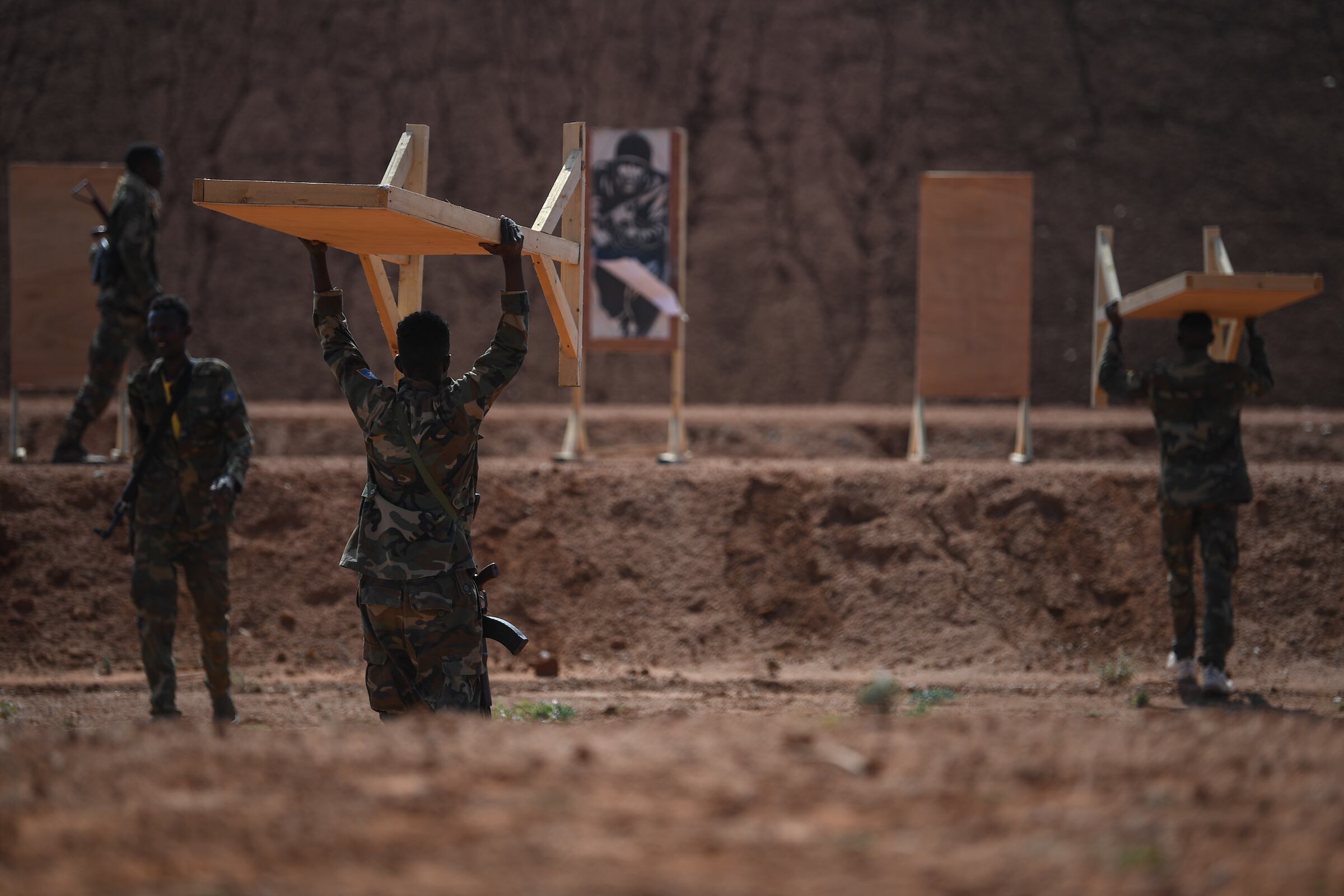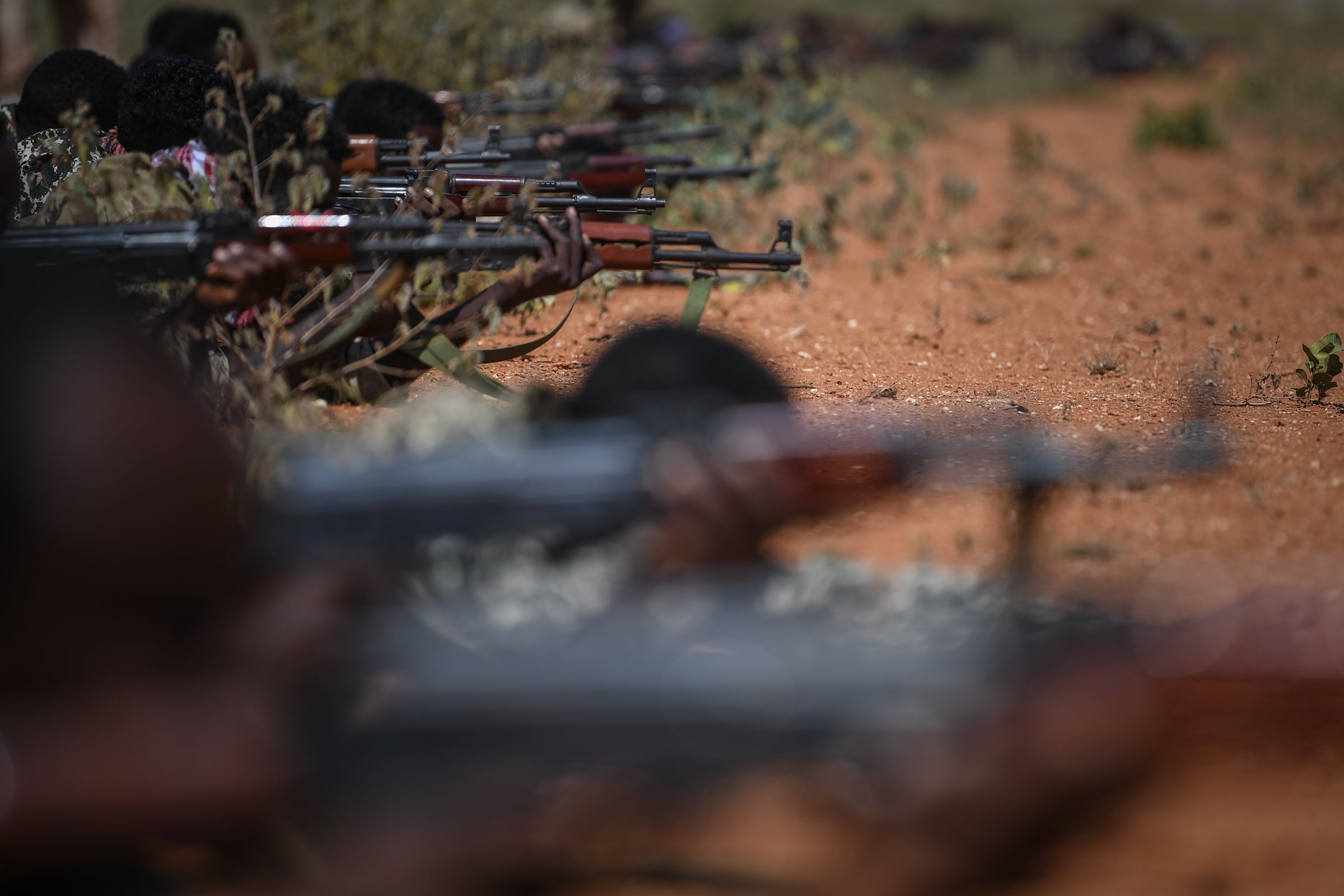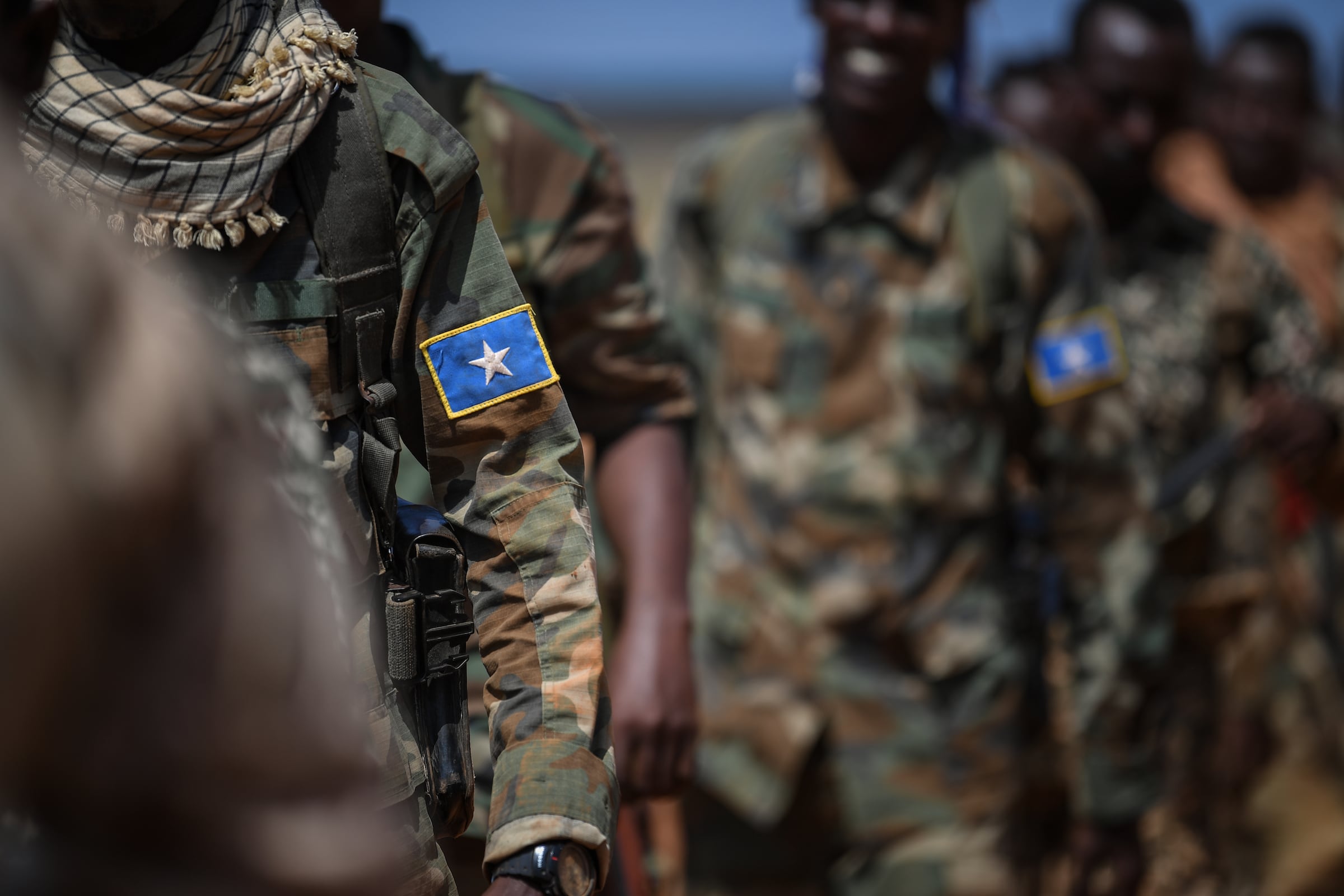U.S. government forces and a contractor with an unorthodox investment strategy have fanned out over Somalia to fight al-Shabaab by building a force of local light infantry known as the Danab — and they’re likely to continue doing so for years to come.
In April, President Donald Trump signed an executive order that extended the U.S. military mission to Somalia for another year, citing the threat from al-Shabaab — a militant group aligned with al-Qaida — as an “unusual and extraordinary threat to the national security."
The move extends a mission that has paired airstrikes with ground operations and nation-building to a noteworthy degree of success.
The U.S. government has used al-Shabaab’s attacks on civilian targets in Somalia and Kenya, as well as its affiliation with al-Qaida, as justification for the military involvement that officials say prevents the country from slipping back into a failed state.
The military commitment to the country hovers between 500 and 600 troops, but an unknown number of contractors are also used to recruit and train Danab light infantry, also known as the Lightning Brigade. Many of those contractors have worked for a nonprofit that shares leaders with an investment arm that has bought up a significant amount of real estate in Somalia.
That contractor, founded as a mine-removal organization in 1999, earns its profits by investing in the stable environments it helps prop up.
Bancroft Global Development works in conflict zones as a nonprofit, but Bancroft Global Investments — a separate legal entity that shares leadership with the nonprofit arm — has made entrepreneurial investments in Somalia and become one of the country’s largest real estate investors and developers.
Bancroft did not return multiple requests for comment, but their connection to the U.S. mission in Somalia was confirmed to Military Times by a U.S. official on background earlier this year, as well as a series of public contracts that show an escalating partnership between the company and the U.S. government.
In May, Bancroft Global Development accepted a more than $730,000 contract for six months of support services. By contrast, Bancroft received about $490,000 for that same type of contract during the previous 12 months.

The nonprofit has several other contracts with the U.S., including a $42,000, one-month lease on Bancroft property in Somalia in December for a conference.
A former Army Green Beret officer experienced with stability operations said that an arrangement with a nonprofit connected to an investment firm was “strange.”
“I’ve never seen a nonprofit conduct foreign internal defense before,” he said. “You don’t need to be an expert for this raise eyebrows.”
Despite it’s unorthodox business model, Bancroft has successfully helped build a competent Danab force out of the small pilot platoon it started out as in 2012, said Paul Williams, an associate professor at George Washington University and author of several books on war in Africa.
“Danab has now grown to around battalion size and has been the only [Somali National Army] unit consistently able to perform offensive operations," Williams said.
Danab’s success, however, has so far not been replicated within the larger Somali National Army, which remains undermanned, poorly equipped and riddled with corruption. And any efforts to scale Bancroft’s operations and the U.S. military advising could be met with resistance from clans that feel threatened.
U.S. assistance to Somali military forces is by policy restricted to units receiving direct mentorship, which is primarily the Danab. Bancroft recruits and trains Danab soldiers based on merit and with their clan considerations in mind, a key feature for the force to not appear as an occupying army in a country where tribalism plays a central role.
Bancroft then puts the recruits through a basic training program. The U.S. mission does not provide basic training to regular Somali soldiers, only those who will become Danab, a State Department official involved in the region told Military Times.
After basic training, those troops are sent to U.S. military advisers, where they’re further honed into offensive forces. Regular Somali soldiers are often used to hold ground that U.S. and Danab troops win back from al-Shabaab.
Sometimes the mission involves direct action for U.S. forces, which include a variety of special operations units, including joint terminal attack controllers, a senior U.S. Africa Command official told Military Times. JTACs are often used to direct artillery and close-air support from a forward location when friendly troops are close to enemy targets.
The U.S. commitment to Somalia is intended as a whole-of-government approach involving international partners, but “substantial involvement by U.S. military personnel on the ground, particularly the Mogadishu coordination cell," takes the lead on building Somalia’s defense apparatus, the State Department official said.
Although al-Shabaab has been rolled back from its height of power a decade ago, the group remains strong, operating in roughly 20 percent of the country. The militants are still capable of carrying out massive attacks in Somalia and surrounding countries, despite the ongoing African Union mission in the country, which planned to hand over security responsibilities to local forces by 2021.
“If [the African Union mission] exits, it would be difficult for the U.S. to operate in Somalia, unless there is a viable Somalia National Army in place that the U.S. troops can work with,” said Zakaria Yusuf, a Kenya-based analyst on Somali issues for International Crisis Group, a nonprofit that conducts field research on violent conflicts.
What are Lightning Brigades?
“When we say Danab, tactically, that’s a capability on the battlefield,” Marine Maj. Gen. Gregg Olson, Directorate of Operations at U.S. Africa Command, said in an interview with Military Times. “Are you trained for offensive combat operations to take the fight to al-Shabaab, to take ground ... then somebody else will likely come behind you and hold.”
The Danab Brigade is supposed to eventually consist of five battalions, with 450 to 500 troops in each. The national security architecture calls for one battalion in each of Somalia’s federal member states, headquartered at Baledogle Airfield — a former Soviet air base in southern Somalia with a significant U.S. air and ground presence.
The majority of equipment for Danab is currently provided through the Defense Department. The U.S. also provides stipends to the Danab personnel once they’ve completed training, on top of the salaries paid by the federal government of Somalia.
The most advanced part of that effort is an initial battalion operating in the South West State of Somalia, called Sector 60, the State Department official said. That region of the country includes Lower Juba, Middle Juba and Lower Shabelle, areas where al-Shabaab has been active.
“We wouldn’t say it’s reached full operational capability in the sense that it does require some external support to actually prosecute operations at this time," the official added. “But that battalion’s sort of been formed fully at this point.”
The State Department official said that there are multiple groups contracted to support Danab forces, “including grantees, cooperative agreement holders and a few cases of direct contracts with commercial firms,” but they declined to confirm or deny the names of those entities.
Organizations like these, of which Bancroft appears the most prominent, provide only the most basic level of military training to new Danab intakes. “And these are the personnel who also, in Sector 60, are responsible for actually handling much of the initial recruiting as well for that effort," the State Department official said.

The contractors do a basic assessing of Danab recruits, checking their physical fitness as well as their political and socioeconomic background.
“We are sensitive to the significant role that clan, sub-clan affiliations play in the Somali security context," the official said. The contractors also must gather biometric data off recruits, which is processed by U.S. government channels to ensure past human rights violators are not recruited.
Somalia has largely made inroads against al-Shabaab thanks to international assistance. The militant group rose to prominence in the mid-2000s, capturing the capital city of Mogadishu and controlling key ports like Kismayo, in the country’s southern region.
Al-Shabaab was expelled from Mogadishu in 2011 thanks to African Union troops, and then lost Kismayo’s lucrative ports in 2012, putting a dent in the group’s financing. Al-Shabaab continued to lose most of its urban holdings, but remained strong in rural regions.
In 2017, the Trump administration stepped up airstrikes in the country, targeting al-Shabaab leaders and training camps.
But the group remains capable of launching large-scale terror attacks, such as an October 2017 bombing in Mogadishu that killed more than 500 people and a January 2019 attack on a hotel in Nairobi, Kenya.
Some analysts point to these operations, as well as the group’s affiliation with al-Qaida, as evidence of the ability to strike Westerners should it not be checked on the battlefields of Somalia. That is the primary justification for U.S. troops to be fighting, and in one case dying, in the country.
How often do U.S. forces fight?
“Somalia is an area of authorized hostilities,” Marine Maj. Gen. Olson said. “Our intention for U.S. forces is to have the Somali partners conduct the operations. Occasionally, as we’re accompanying Somalis into the field, U.S. forces find themselves in situations where they have to either defend themselves or assist a partner in defending themselves.”
“Those happen occasionally, but the intention of U.S. forces when they take to the field is to advise and accompany the partner where the partner conducts the actions," Olson added.
The U.S. often operates command and control centers from where they can track partner forces utilizing aircraft sensors and radios, even if Americans aren’t physically involved in the mission.
“We often hear of joint U.S. and Danab missions in different parts of Somalia, and how closely the two forces work together,” said Yusuf, the Kenya-based security analyst. “Literally, Danab cannot operate alone without the needed U.S. support. It heavily depends on U.S. intelligence gathering, and also in supplies and logistics.”
There are various orders that provide U.S. troops the authority to operate in Somalia. Some of those mission names were leaked last year, including several 127 Echo programs, a budgetary authority that allows U.S. troops to control military units from other countries as a sort of “surrogate force.”

Officials would not comment on which missions are still active and which authorities govern each.
“It’s important to emphasize that the formations that we’re training, advising, assisting either accompany Danab or are part of Danab themselves or are working with [the African Union],” Olson said.
U.S. forces operate across the entirety of Somalia, but there are some places where the effort is more mature, Olson said. There has been a longstanding partnership with the Puntland security forces in northern Somalia, he noted, as well as Baledogle Airfield further south.
“Somalia is the size of the East Coast of the United States. So we have forces distributed from the equivalent of Albany, New York to about Tallahassee, Florida," Olson said. "And we have a limited number of assets that support them.”
U.S. troops are sometimes outside the wire, as evidenced by the death of Army Staff Sgt. Alexander Conrad, who was killed by al-Shabaab mortar teams in July 2018.
“Every mission that goes outside the wire is supported to a standard that permits us to react to what that force needs, whether it’s fire support, whether it’s personnel recovery, whether it’s medical support,” Olson said. "We carefully examine the minimum force requirements for every single mission, and we help make sure that they’re all supported to the standard.”
Long-term goals
The military mission in Somalia feeds into the national security architecture that Somali leaders arrived at during a May 2017 London conference on the situation in the country. At that meeting, the Federal Government of Somalia and its member states agreed on a federated security model that is intended to serve as the super structure for the Somali security forces.
The U.S. mission to the country is trying to help that process by setting up a national security architecture, which also includes civil society projects by U.S. diplomats and the U.S. Agency for International Development.
Danab is the most successful military initiative thus far.
“The elite commando unit trained by the Americans have been very useful, especially in combating the Al-Shabaab threat in Somalia,” Yusuf said. “But their numbers need be increased so they could reinforce Somalia National Army when it comes to operations against Al-Shabaab.”
Yusuf said the U.S. military’s focus on Danab is the right approach. “Al-Shabaab can only be defeated by ground-based troops such as Danab,” he said, noting that airstrikes do weaken the militants’ ability to operate freely in Somali, but also risk civilian casualties, which empowers the militants with propaganda.
“In the unfortunate incident that the Somali government in Mogadishu weakens or disintegrates, then it means every member [of Danab] goes back to their clans,” Yusuf said. "Just like the Somalia army disintegrated in 1991.”
Any external effort to build domestic security forces always runs the risk of empowering local strongmen, but the need to establish security outweighs that danger, according to Williams, the George Washington University professor.
“Africa has numerous examples of leaders manipulating armed forces to produce presidential guards or deliberately fragmenting them to guard against coups,” Williams said. "But those risks must be weighed against the existing problems that are exacerbated by the lack of an effective army.”
Bancroft’s long-term goal in all of this appears to be financial, but investment in a country’s infrastructure isn’t necessarily nefarious.
The company’s portfolio reportedly includes property development coupled with hydroelectric and solar power, wireless telecommunications, virtual banking and modern freight transport. From Bancroft’s perspective, its structure of security assistance, paired with investment, benefits both local people and investors.
For example, the company built an international campus at the Mogadishu International Airport several years ago that now hosts many foreign visitors, Williams said. “This was a prudent financial decision but it also provided employment and skills to over 800 young Somali men,” he added.
Expanding the lessons learned by cultivating Danab to the greater Somali military is the best way to continue making security gains, according to Yusuf.
In the end, that could mean greater cooperation with groups like Bancroft, if what they offer is scalable.
“Danab’s significance is both operational and symbolic, that is, showing that with proper training, equipment, financing and mentoring, multi-clan, meritocratic units are possible," Williams said. "However, scaling this up from a battalion to a brigade or even beyond will run up against powerful clan-based interests in Somalia.”
Kyle Rempfer was an editor and reporter who has covered combat operations, criminal cases, foreign military assistance and training accidents. Before entering journalism, Kyle served in U.S. Air Force Special Tactics and deployed in 2014 to Paktika Province, Afghanistan, and Baghdad, Iraq.









